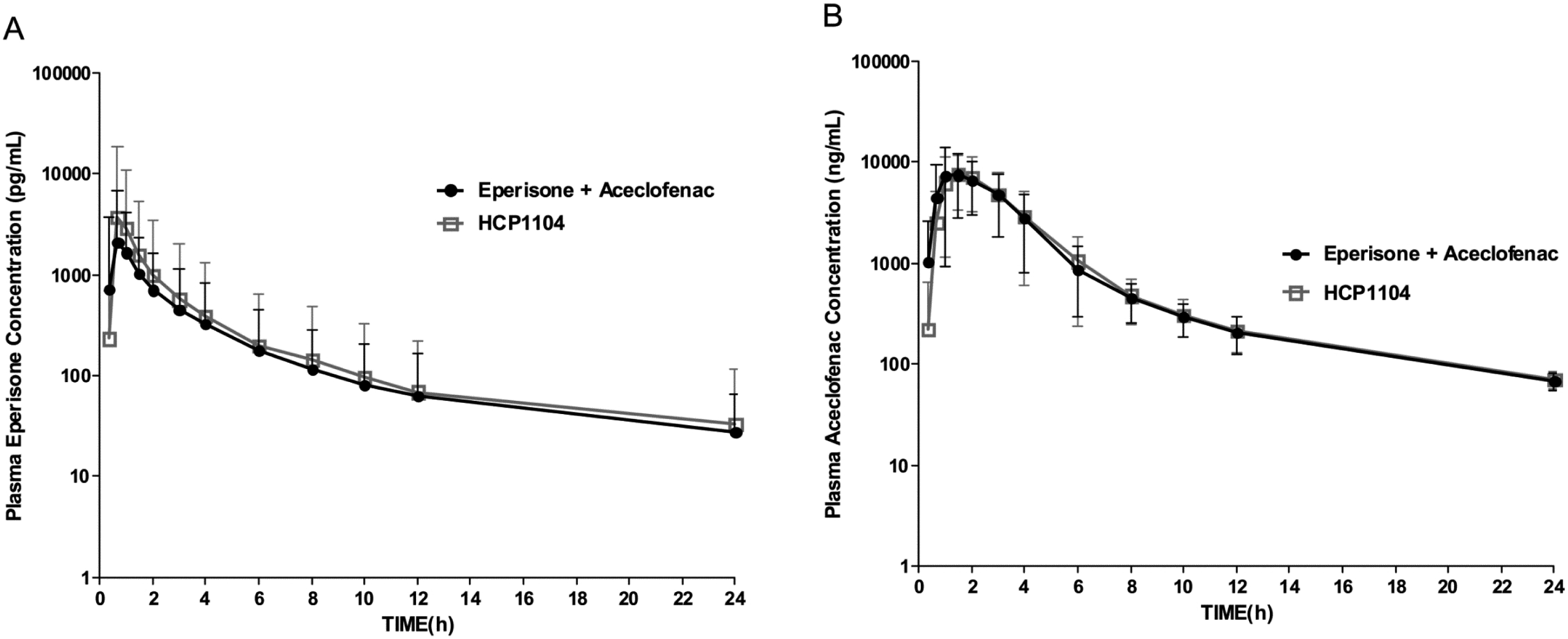Abstract
Background:
This clinical study was conducted to compare pharmacokinetics of eperisone and aceclofenac of HCP1104, a new fixed dose combination drug with those in co-administration of eperisone 50 mg and aceclofenac 100 mg. The study used a partial replicated study design to characterize intra-subject variability of eperisone when co-administrated with aceclofenac.
Methods:
A partial replicated crossover design was employed in 30 subjects. Each subject received a single dose of co-administration of eperisone 50 mg and aceclofenac 100 mg on two occasions and a single dose of 1 capsule of HCP1104. Blood samples were obtained for 24 hrs after dosing, and plasma was assayed for eperisone and aceclofenac by Liquid chromatography-electrospray ionization-mass spectrometry.
Results:
Using an average bioequivalence criterion, the 90 % confidence limits for Ln-transformed Cmax and AUClast for aceclofenac fell wihin the acceptable range of 80 - 125 %. Point estimates of eperisone AUClast and Cmax were 1.0152 and 1.0490, respectively and the 90 % confidence interval for Cmax was 0.8499 - 1.3025. The within-subject coefficient of variation of Cmax for the reference was 50.198 %. Acceptance range for eperisone Cmax based on new bioequivalence guidance for highly variable drugs was extended to 0.6984 - 1.4319.
Conclusion:
The extent of exposure and rate of absorption of both eperisone and aceclofenac with a single dose of HCP1104 capsule were equivalent to those with co-administration of a marketed eperisone 50 mg tablet and a marketed aceclofenac 100 mg tablet under fasting conditions in healthy adult males.
Go to : 
REFERENCES
1. Dooley M, Spencer CM, Dunn CJ. Aceclofenac: a reappraisal of its use in the management of pain and rheumatic disease. Drugs. 2001; 61(9):1351–1378.
2. Brogden RN, Wiseman LR. Aceclofenac. A review of its pharmacodynamic properties and therapeutic potential in the treatment of rheumatic disorders and in pain management. Drugs. 1996; 52(1):113–124.
3. Melilli B, Piazza C, Vitale DC, Marano MR, Pecori A, Mattana P, Volsi VL, Iuculano C, Cardi F, Drago F. Human pharmacokinetics of the muscle relaxant, eperisone hydrochloride by liquid chromatography-electrospray tandem mass spectrometry. Eur J Drug Metab Pharmacokinet. 2011; 36(2):71–78.

4. Sartini S, Guerra L. Open experience with a new myorelaxant agent for low back pain. Adv Ther. 2008; 25(10):1010–1018.

5. Myonal drug information. http://www.eisai.jp/medical/products/di/EPI/MYO_T-G_EPI.pdf. [Online] (last visited on Nov 15 2013).
6. Tothfalusi L, Endrenyi L. Sample sizes for designing bioequivalence studies for highly variable drugs. J Pharm Pharm Sci. 2012; 15(1):73–84.

7. Kim MJ, Lim HS, Noh YH, Kim YH, Choi HY, Park KM, Kim SE, Bae KS. Pharmacokinetic interactions between eperisone hydrochloride and aceclofenac: a randomized, open-label, crossover study of healthy korean men. Clin Ther. 2013; 35(10):1528–1535.

8. World Medical Association. World Medical Association Declaration of Helsinki. Ethical principles for medical research involving human subjects. Bull World Health Organ. 2001; 79(4):373–374.
9. RBORT XP, CARRASCO E., GOMEZLECHEON M.J., CASTEL J.V.Metabolism of aceclofenac in humans. Drug metabolism and disposition. 1996; 24(8):834–841.
10. Agency EM. Guideline on the Investigation of Bioequivalence. Committee for Medicinal Products for Human Use. CHMP;London: 2010.
Go to : 
 | Figure 1.Plasma eperisone concentration - time curve (A) and plasma aceclofenac concentration - time curve (B) when administrated eperisone 50 mg with aceclofenac 100 mg or HCP1104 alone. Mean and standard deviation are presented as point and bars, respectively. |
Table 1.
Study design
| Sequence | Number of subject | Period 1 | Period 2 | Period 3 |
|---|---|---|---|---|
| 1 | 10 | R* | R* | Tf |
| 2 | 10 | R* | Tf | R* |
| 3 | 10 | Tf | R* | R* |
Table 2.
Pharmacokinetic parameters of eperisone and aceclofenac following HCP1104 and co-administration of eperisone 50 mg and aceclofenac 100 mg in healthy male subjects
Table 3.
Summary statistics of eperisone and aceclofenac following single oral dose administration of HCP1104 and co-administration of eperisone 50 mg and aceclofenac 100 mg in healthy male subjects
Table 4.
Treatment-emergent adverse event




 PDF
PDF ePub
ePub Citation
Citation Print
Print


 XML Download
XML Download